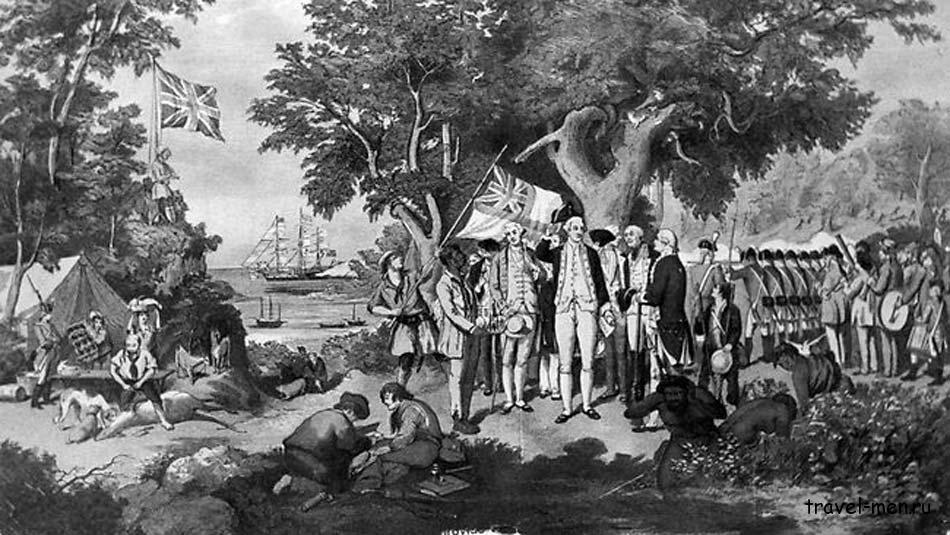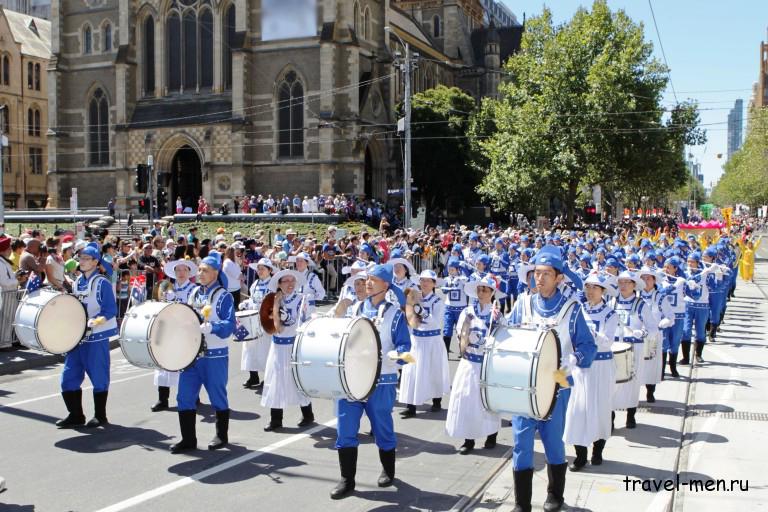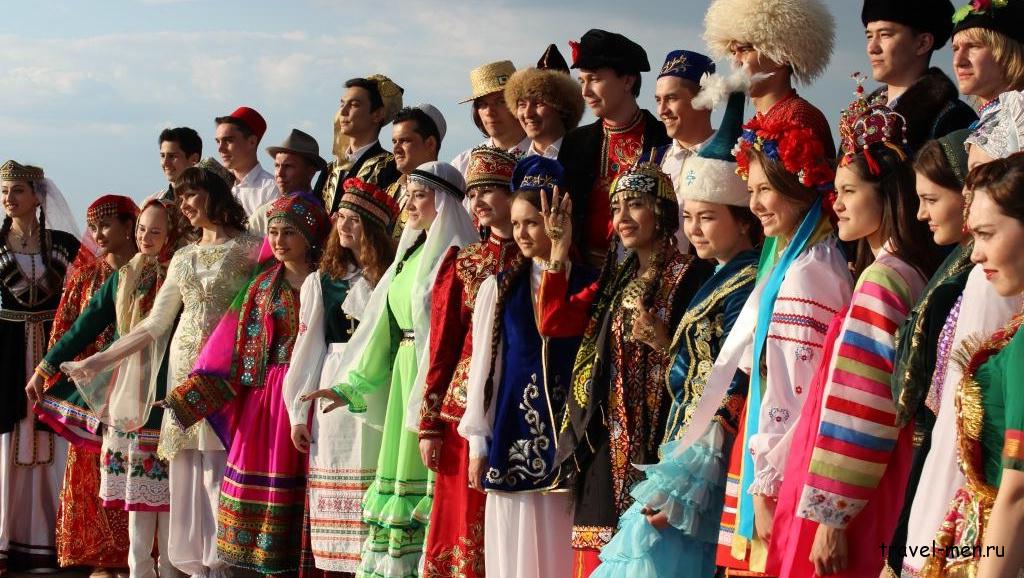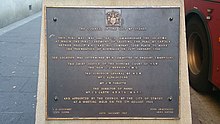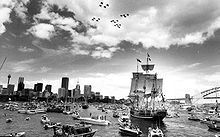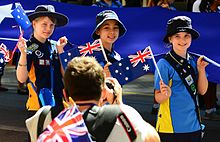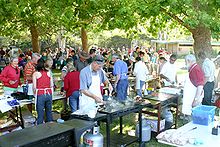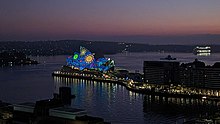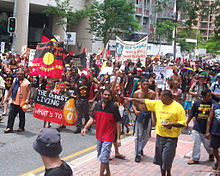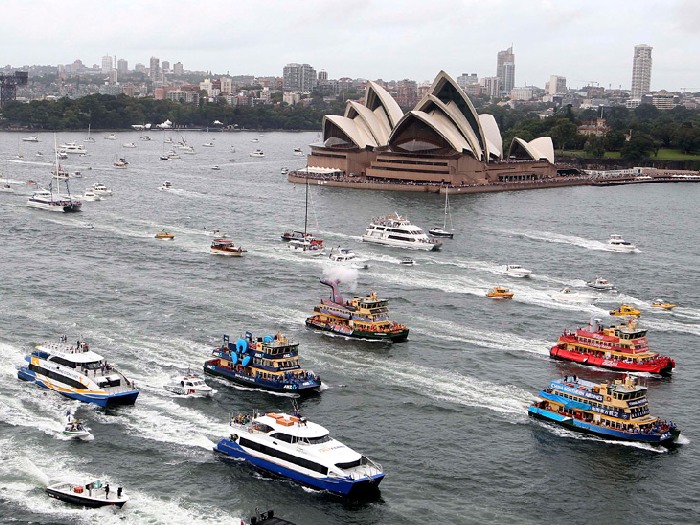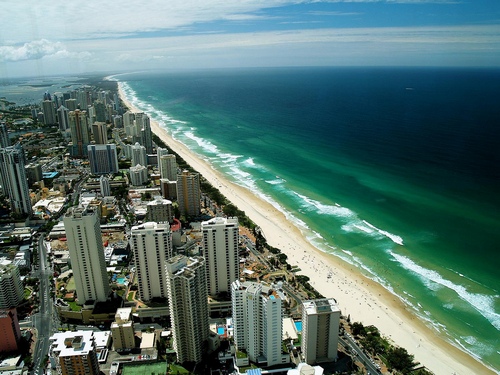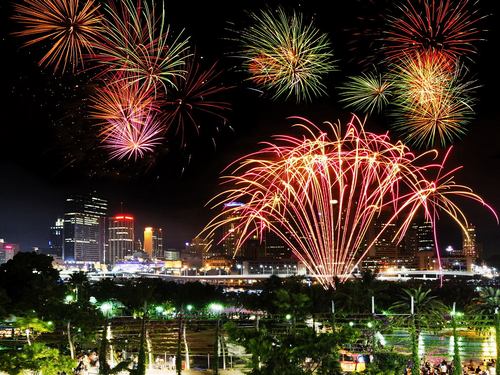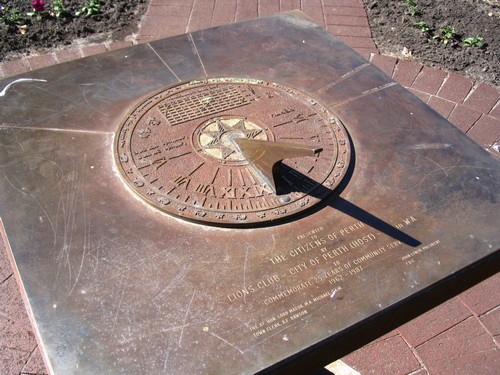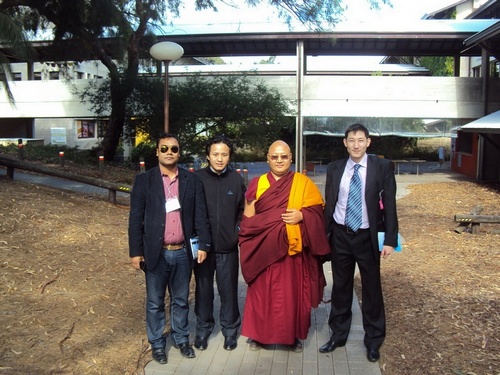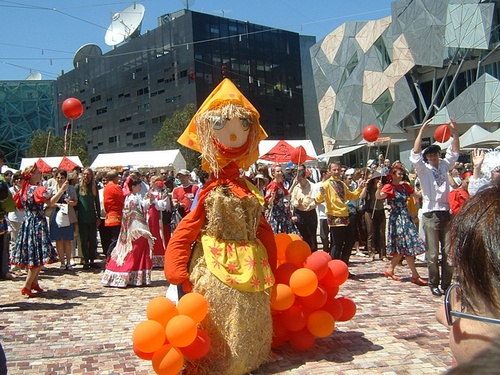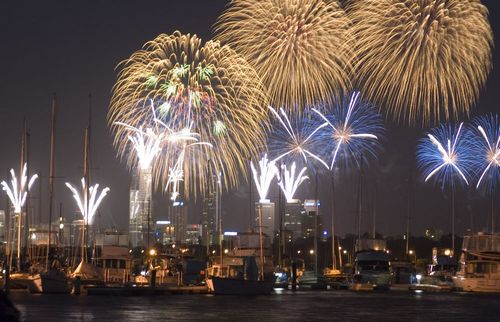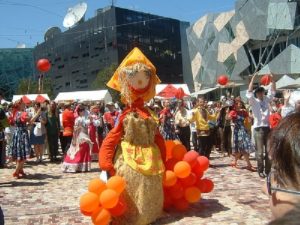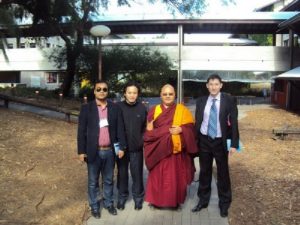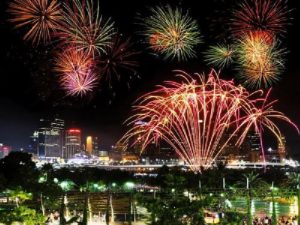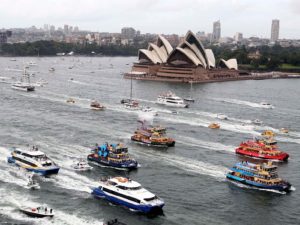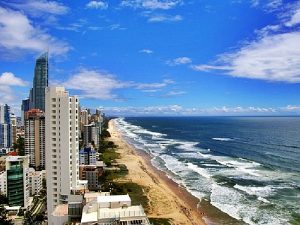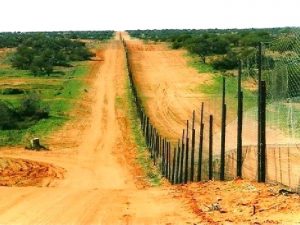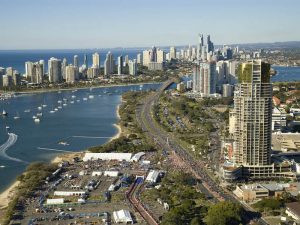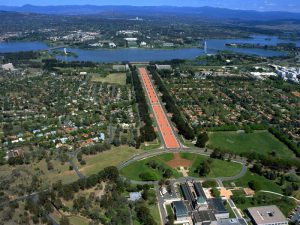
День Австралии (Australia Day) — национальный и любимейший праздник австралийцев — знаменует начало освоения Зеленого континента европейцами. 26 января 1788 года капитан Артур Филипп (Arthur Phillip) высадился в бухте Сиднея, поднял британский флаг и основал первую колонию — Новый Южный Уэльс.
Это произошло 18 лет спустя после открытия континента капитаном Джеймсом Куком.
Филипп назвал новое поселение «Сидней» по имени Томаса Тауншенда, первого виконта Сиднея, секретаря Британской империи в 1784—89 годах, который и отдал приказ отправить флот.
Первый флот состоял из двух военных кораблей — Сириуса и Сэпплая — и девяти товарных. Есть запись о том, что на кораблях находились 192 женщины-заключенные, 564 мужчины, 450 матросов, гражданский и военный персонал, 28 жен и 30 детей.
День Австралии — любимейший праздник австралийцев (Фото: Leah-Anne Thompson, по лицензии Shutterstock.com)
До 1808 года этот день отмечался как День первой высадки или День Основания. В 1818 году — на 30-летие колонии — губернатор Маккуаэри велел произвести салют из 30 орудий и дал государственным служащим выходной. Вскоре эту традицию переняли банки и многие общественные организации. В 1888 году все столицы колоний (за исключением Аделаиды) отпраздновали столетие высадки первого флота как День юбилея, а к 1935 году все штаты страны праздновали 26 января как День Австралии.
Долгое время официальный выходной приходился на понедельник, ближайший к 26 января. С 1994 года официальный выходной и все празднования приходятся именно на 26 января.
В День Австралии по всей стране воспроизводится высадка первого флота, проходят многочисленные регаты и парады. Празднование знаменуют многочисленные фейерверки. Самые большие световые шоу ежегодно проходят в третьем по величине городе страны — Перте.
В этот день в Сиднее стартует музыкальный фестиваль, в Аделаиде — матч по крикету. В Канберре проходит концерт живой музыки, а также вручение одной из самых почетных наград страны — Австралиец года. По традиции, с обращением к нации выступает премьер-министр.
По всей стране проходят многочисленные регаты (Фото: oksana.perkins, по лицензии Shutterstock.com)
День Австралии — идеальное время надеть майку, шляпу, носки (да что угодно!) с австралийским флагом и носить это с нескрываемой гордостью. А также самое время украсить дом шарами и флагами — чтобы он выглядел празднично. Есть и такая традиция: коллеги австралийцев, работающих за границей, дарят им в этот день подарки. Работникам-австралийцам разрешен долгий ланч или даже возможность уйти с работы пораньше.
В то время как для большинства австралийцев британского происхождения 26 января — праздник, многие аборигены воспринимают его как День траура. Как истинные хозяева земель, аборигены считают этот исторический факт началом утраты своих прав жить, как они жили в течение 40 тысяч лет. Поэтому коренные австралийцы сегодня прилагают все усилия, чтобы восстановить эти права и вернуть уважение к своей культуре и традициям.
Материалы по теме в Журнале Calend.ru:
• Статья «Чем Австралия удивляет иммигрантов из России?»
Содержание страницы
- 1 День Австралии: уникальная история торжества
- 2 С чего всё начиналось: от высадки на австралийском берегу до государственного празднества
- 3 Национальный день новой Австралии
- 4 У каждого народа – свой главный праздник
- 5 Интересные записи:
День Австралии: уникальная история торжества
Национальный праздник – не просто важен, он наделён особым смыслом. В России 12 июня отмечают с огромным размахом внутри страны и на общенациональном уровне как День суверенитета РФ после распада СССР. У австралийцев знаменательный для всей страны — День Австралии 26 января – самое необычное, яркое и любимое каждым, от мала до велика, веселое торжество.
20 лет назад этот день отметили в календаре как официальный выходной и даже те австралийцы, которые живут за пределами родины, имеют право в праздник на продление обеденного перерыва, а в некоторых местах им дается дополнительно полноценный уик-энд.
Как у любого другого национального торжества, День Австралии имеет богатую историю своего образования, внесено было немало изменений и поправок и он стал поистине любим всеми жителями, несмотря на неоднозначное первоначальное отношение к нему коренного населения Зелёного континента.
С чего всё начиналось: от высадки на австралийском берегу до государственного празднества
26 января 1788 года, к берегам Пятого континента подошли корабли Королевского флота Англии, капитан главного судна Артур Филипп установил флаг своего королевства на австралийской земле, отметив прибытие европейцев и колонизацию местного населения. Коммерческие и боевые корабли англичан привезли больше 1500 человек, среди которых были матросы, торговцы, осужденные, военные, а также их супруги и дети.
Как раз капитан Филипп и стал основателем Сиднея, в который первоначально ссылали преступников на поселение.
С этого момента прибывшие новоавстралийцы праздновали 26 января свой первый день высадки. Через 30 лет праздник стал формально выходным. Через 100 лет, в 1888 году, ему дали название — День Юбилея, и лишь в 1935 году 26 января стали отмечать по всему континенту под окончательным именем — Днем Австралии.
Национальный день новой Австралии
Не всегда День Австралии был таким ожидаемым и обожаемым всеми праздником. В те времена, коренные австралийцы считали этот день самым печальным, ведь британцы захватили их родные земли и, как они считали, ничего хорошего это не обещало. Однако, со временем аборигены наблюдали одни только улучшения: вырос уровень жизни не только поселенцев, но и коренных жителей. И на сегодняшний момент аборигены приняли традиционные празднования и торжество стало по-настоящему всеобщим.
В канун 26 января в столице Австралии вручают авторитетную премию «Австралиец года». Непосредственно в сам праздник по всему континенту проходят грандиозные парады, регаты, захватывающие театрализованные выступления с сюжетом первой высадки колонизаторов, потрясающие световые шоу с грандиозными фейерверками, веселые гулянья на пляжах, праздничные шествия и спортивные состязания, не говоря уже о выставках, флешмобах и разного рода танцевальных шоу.
Начинаются празднования в Австралии 26 января с общепринятых официальных речей, поднятия национального флага, дружное исполнение австралийцами государственного гимна, дополняет все пушечный залп и торжественная церемония вручения гражданства новыми жителям страны. Даже завтрак проходит не, как обычно – это своеобразные утренние барбекю в компании семьи, друзей или соседей.
Целый день и несколько дней после на каждом доме в каждом дворе, на балконах, машинах и на людях – буквально везде можно увидеть государственные флаги — символ сплоченности народа, которому пришлось пройти нелегкий путь от колонизации до независимого государства.
К 26-му января сотни австралийцев съезжаются в Сидней, чтобы стать частью грандиозного празднования и полюбоваться водными шоу в Сиднейской бухте, куда и пристали корабли англичан в 8-м веке. В это же время в сиднейском ботаническом саду устраивают церемонию Встреча вод (Вогган-ма-гуле), чтобы отдать дань уважения коренным жителям.
Кому хоть раз повезло побывать в Австралии на национальном празднике, тем посчастливилось прочувствовать дух любви к Родине, которым наполнен каждый австралиец, и заразиться этим непередаваемым настроением.
У каждого народа – свой главный праздник
Население каждой страны гордится своей Родиной, любит её и потому государственный праздник так важен и значим. Это может быть не только день основания, но также освобождение, независимость или воссоединение. Каждое, такого рода, торжество отмечается совсем в ином формате нежели все остальные праздники, не только внутри страны, а в общенациональном масштабе.
В России 12 июля также официальный выходной, в тот же день отмечают и День города в некоторых областях, проходят концерты и торжества, запускают салюты. В Москве вручают госпремии.
Для Германии важный государственный день — Единство 3 октября, когда подписывался Договор объединения Германии, позволивший убрать стену между ГДР и ФРГ во всех смыслах.
В Бразилии 7 сентября празднуется день независимости, проходит величайший парад военной техники, на который съезжаются более 30000 человек. Каждый бразилец очень уважительно относится к главному торжественному дню своей страны.
В какой бы стране не жил человек, чьи бы традиции ни соблюдал, важно всегда помнить и ценить свою Родину, беречь то единство и демократию, которых наши предки добивались порой ценой своей жизни, а также бережно передавать знания и воспитывать уважение к Родине у будущих поколений. Нужно любить свою Родину, неважно каких она размеров и сколько в ней богатств. Ведь главное национальное достояние каждой страны – это её народ. При этом нужно уважать также традиции и единство других наций, соблюдая демократичность.
Перейти на главную страницу
| Australia Day | |
|---|---|
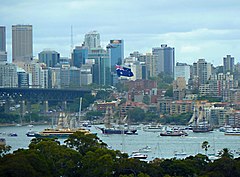
Sydney Harbour on Australia Day, 2014 |
|
| Also called |
|
| Observed by | Australian citizens, residents and expatriates |
| Type | National |
| Significance | Date of landing of the First Fleet in Port Jackson in 1788 |
| Observances | Family gatherings, fireworks, picnics and barbecues, parades, citizenship ceremonies, Australia Day honours, Australian of the Year presentation |
| Date | 26 January |
| Frequency | Annual |
Australia Day is the official national day of Australia. Observed annually on 26 January, it marks the 1788 landing of the First Fleet at Sydney Cove[a] and raising of the Union Flag by Arthur Phillip following days of exploration of Port Jackson in New South Wales. In present-day Australia, celebrations aim to reflect the diverse society and landscape of the nation and are marked by community and family events, reflections on Australian history, official community awards and citizenship ceremonies welcoming new members of the Australian community.[1]
The meaning and significance of Australia Day has evolved and been contested over time, and not all states historically celebrated the same date as their date of historical significance.[2] The date of 26 January 1788 marks the proclamation of British sovereignty over the eastern seaboard of Australia.[3] Records of celebrations on 26 January date back to 1808, with the first official celebration of the formation of New South Wales held in 1818. It was not until 1935 that all Australian states and territories adopted use of the term «Australia Day» to mark the date of the 1788 landing of the First Fleet at Sydney Cove, and not until 1994 that 26 January was consistently marked by a public holiday on that day by all states and territories.[4] Historically, the date was also variously named Anniversary Day, Foundation Day and ANA Day.[5]
In contemporary Australia, the holiday is marked by the presentation of the Australian of the Year Awards on Australia Day Eve, announcement of the Australia Day Honours list and addresses from the Governor-General and Prime Minister. It is an official public holiday in every state and territory. With community festivals, concerts and citizenship ceremonies, the day is celebrated in large and small communities and cities around the nation. Australia Day has become the biggest annual civic event in Australia.[6]
Indigenous Australian events are now included. However, since at least 1938,[7] the date of Australia Day has also been marked by some Indigenous Australians and supporters mourning what is seen as the invasion of the land – which they had occupied for millennia – by the British and the start of colonisation, protesting its celebration as a national holiday. Invasion Day, Survival Day, or Day of Mourning is observed by many as a counter-observance on 26 January, with calls for the date of Australia Day to be changed[8][9] or the holiday to be abolished entirely.[10][11] Support for changing the date is a minority position; however, polls indicate some support, particularly among Australians under age 30.[12][13][14][15][16][17]
History
Arrival of the First Fleet: 1788
On 13 May 1787 a fleet of 11 ships, which came to be known as the First Fleet, was sent by the British Admiralty from England to New Holland.[b] Under the command of Naval Captain Arthur Phillip, the fleet sought to establish a penal colony at Botany Bay on the coast of New South Wales, which had been explored and claimed by Lieutenant James Cook in 1770. The settlement was seen as necessary because of the loss of the Thirteen Colonies in North America.[18] The Fleet arrived between 18 and 20 January 1788, but it was immediately apparent that Botany Bay was unsuitable.
On 21 January, Phillip and a few officers travelled to Port Jackson, 12 kilometres (7.5 mi) to the north, to see if it would be a better location for a settlement. They stayed there until 23 January; Phillip named the site of their landing Sydney Cove, after the Home Secretary, Thomas Townshend, 1st Viscount Sydney. They also made contact with the local Aboriginal people.
They returned to Botany Bay on the evening of 23 January, when Phillip gave orders to move the fleet to Sydney Cove the next morning, 24 January. That day, there was a huge gale blowing, making it impossible to leave Botany Bay, so they decided to wait till the next day, 25 January. However, during 24 January, they spotted the ships Astrolabe and Boussole, flying the French flag, at the entrance to Botany Bay; they were having as much trouble getting into the bay as the First Fleet was having getting out.[citation needed]
On 25 January the gale was still blowing; the fleet tried to leave Botany Bay, but only HMS Supply made it out, carrying Arthur Phillip, Philip Gidley King, some marines and about 40 convicts; they anchored in Sydney Cove in the afternoon. Meanwhile, back at Botany Bay, Captain John Hunter of HMS Sirius made contact with the French ships, and he and the commander, Captain de Clonard, exchanged greetings. Clonard informed Hunter that the fleet commander was Jean-François de Galaup, comte de La Pérouse. Sirius successfully cleared Botany Bay, but the other ships were in great difficulty. Charlotte was blown dangerously close to rocks, Friendship and Prince of Wales became entangled, both ships losing booms or sails, Charlotte and Friendship collided, and Lady Penrhyn nearly ran aground. Despite these difficulties, all the remaining ships finally managed to clear Botany Bay and sail to Sydney Cove on 26 January. The last ship anchored there at about 3 pm.[19]
Captain Arthur Phillip raising the British flag at Sydney Cove, 26 January 1788. Oil sketch by Algernon Talmage, 1937.
Foundation of Australia plaque, Loftus Street, Circular Quay
So it was on 26 January that a landing was made at Sydney Cove and clearing of the ground for an encampment immediately began. Then, according to Phillip’s account:[20]
In the evening of the 26th the colours were displayed on shore, and the Governor, with several of his principal officers and others, assembled round the flag-staff, drank the king’s health, and success to the settlement, with all that display of form which on such occasions is esteemed propitious, because it enlivens the spirits, and fills the imagination with pleasing presages.
— The Voyage of Governor Phillip to Botany Bay
The formal establishment of the Colony of New South Wales did not however occur on 26 January as is commonly assumed. It did not occur until 7 February 1788, when the formal proclamation of the colony and of Arthur Phillip’s governorship were read out. The vesting of all land in the reigning monarch King George III also dates from 7 February 1788.[21][22][23]
1788–1838
Although there was no official recognition of the colony’s anniversary, with the New South Wales Almanacks of 1806 and 1808 placing no special significance on 26 January,[24] by 1808 the date was being used by the colony’s immigrants, especially the emancipated convicts, to «celebrate their love of the land they lived in»[25] with «drinking and merriment».[26] The 1808 celebrations followed this pattern, beginning at sunset on 25 January and lasting into the night, the chief toast of the occasion being Major George Johnston. Johnston had the honour of being the first officer ashore from the First Fleet, having been carried from the landing boat on the back of convict James Ruse. Despite suffering the ill-effects of a fall from his gig on the way home to Annandale, Johnston led the officers of the New South Wales Corps in arresting Governor William Bligh on the following day, 26 January 1808, in what became known as the «Rum Rebellion».
Almanacs started mentioning «First Landing Day» or «Foundation Day» and successful immigrants started holding anniversary dinners.[2] In 1817 The Sydney Gazette and New South Wales Advertiser reported on one of these unofficial gatherings at the home of Isaac Nichols:
On Monday the 27th ult. a dinner party met at the house of Mr. Isaac Nichols, for the purpose of celebrating the Anniversary of the Institution of this Colony under Governor Philip, which took place on 26 Jan. 1788, but this year happening upon a Sunday, the commemoration dinner was reserved for the day following. The party assembled were select, and about 40 in number. At 5 in the afternoon dinner was on the table, and a more agreeable entertainment could not have been anticipated. After dinner a number of loyal toasts were drank, and a number of festive songs given; and about 10 the company parted, well gratified with the pleasures that the meeting had afforded.
— The Sydney Gazette and New South Wales Advertiser[27]
1818 was the 30th anniversary of the founding of the colony, and Governor Lachlan Macquarie chose to acknowledge the day with the first official celebration.[28] The governor declared that the day would be a holiday for all government workers, granting each an extra allowance of «one pound [450 grams] of fresh meat», and ordered a 30-gun salute at Dawes Point – one for each year that the colony had existed.[29] This began a tradition that was retained by the Governors that were to follow.[25]
The first in what would become the Sydney Regatta tradition, 26 January 1838.
Foundation Day, as it was known at the time, continued to be officially celebrated in New South Wales, and in doing so became connected with sporting events.[28] One of these became a tradition that is still continued today: in 1837 the first running of what would become the Australia Day regatta was held on Sydney Harbour.[25][30] Five races were held for different classes of boats, from first class sailing vessels to watermen’s skiffs, and people viewed the festivities from both onshore and from the decks of boats on the harbour, including the steamboat Australian and the Francis Freeling—the latter running aground during the festivities and having to be refloated the next day.[31] Happy with the success of the regatta, the organisers resolved to make it an annual event.[30] However, some of the celebrations had gained an air of elitism, with the «United Australians» dinner being limited to those born in Australia.[25] In describing the dinner, the Sydney Herald justified the decision, saying:
The parties who associated themselves under the title of «United Australians» have been censured for adopting a principle of exclusiveness. It is not fair so to censure them. If they invited emigrants to join them they would give offence to another class of persons – while if they invited all they would be subject to the presence of persons with whom they might not wish to associate. That was a good reason. The «Australians» had a perfect right to dine together if they wished it, and no one has a right to complain.
— The Sydney Herald[32]
The following year, 1838, was the 50th anniversary of the founding of the colony, and as part of the celebrations Australia’s first public holiday was declared. The regatta was held for a second time, and people crowded the foreshores to view the events, or joined the five steamers (Maitland, Experiment, Australia, Rapid, and the miniature steamer Firefly) to view the proceedings from the water. At midday 50 guns were fired from Dawes’ Battery as the Royal Standard was raised, and in the evening rockets and other fireworks lit the sky.[33] The dinner was a smaller affair than the previous year, with only 40 in attendance compared to the 160 from 1837,[32][33] and the anniversary as a whole was described as a «day for everyone».[28]
1839–1935
NSW state banquet to commemorate «the first 100 years of Australian settlement», 26 January 1888
Prior to 1888, 26 January was very much a New South Wales affair, as each of the colonies had its own commemoration for its founding. In Tasmania, Regatta Day occurred initially in December to mark the anniversary of the landing of Abel Tasman.[34] South Australia celebrated Proclamation Day on 28 December. Western Australia had its own Foundation Day (now Western Australia Day) on 1 June.[25]
The decision to mark the occasion of the First Fleet’s arrival in 1788 at Sydney Cove and Captain Arthur Phillip’s proclamation of British sovereignty over the eastern continent on 26 January was first made outside NSW by the Australian Natives’ Association (ANA), a group of white «native-born» middle-class men formed in Victoria in 1871.[35] They dubbed the day «ANA Day».[5]
In 1888, all colonial capitals except Adelaide celebrated «Anniversary Day». In 1910, South Australia adopted 26 January as «Foundation Day»,[25] to replace another holiday known as Accession Day, which had been held on 22 January to mark the accession to the throne of King Edward VII, who died in May 1910.[36]
The first Australia Day was established in response to Australia’s involvement in World War I. In 1915, Ellen «Ellie» Wharton Kirke MBE, née Clements, mother of four servicemen, thought up the idea of a national day, with the specific aim of raising funds for wounded soldiers,[37] and the term was coined to stir up patriotic feelings.[38][36] In 1915 a committee to celebrate Australia Day was formed, and the date chosen was 30 July,[39] on which many fund-raising efforts were run to support the war effort.[40] It was also held in July in subsequent years of World War I: on 28 July 1916,[40] 27 July 1917,[41] and 26 July 1918.[42]
The idea of a national day to be celebrated on 26 January was slow to catch on, partly because of competition with Anzac Day.[43] Victoria adopted 26 January as Australia Day in 1931,[28] and by 1935, all states of Australia were celebrating 26 January as Australia Day (although it was still known as Anniversary Day in New South Wales).[25] The name «Foundation Day» persisted in local usage.[44]
1936–1960s
Sesquicentenary parade in Sydney, 26 January 1938
The 150th anniversary of British settlement in Australia in 1938 was widely celebrated. Preparations began in 1936 with the formation of a Celebrations Council. In that year, New South Wales was the only state to abandon the traditional long weekend, and the annual Anniversary Day public holiday was held on the anniversary day – Wednesday 26 January.[25]
The Commonwealth and state governments agreed to unify the celebrations on 26 January as «Australia Day» in 1946,[45] although the public holiday was instead taken on the Monday closest to the anniversary.[46]
The Nationality and Citizenship Act 1948 came into effect on 26 January 1949, creating Australian citizenship for the first time. Previously, the government-approved residents of Australia had only been «British nationals»; now they had both Australian and British nationality.[47]
Historian Ken Inglis wrote in 1967 that Australia Day was not celebrated publicly in Canberra at that time.[43]
1988: Bicentenary
Sydney Harbour, 26 January 1988
In 1988, the celebration of 200 years since the arrival of the First Fleet was organised on a large scale as the Australian Bicentenary, with many significant events taking place in all major cities.[25] Over 2.5 million people attended the event in Sydney.[28] These included street parties, concerts, including performances on the steps and forecourt of the Sydney Opera House and at many other public venues, art and literary competitions, historic re-enactments, and the opening of the Powerhouse Museum at its new location. A re-enactment of the arrival of the First Fleet took place in Sydney Harbour, with ships that had sailed from Portsmouth a year earlier taking part.[25][28]
Contemporary celebrations
Prime Minister Julia Gillard at the 2013 National Flag Raising and Citizenship Ceremony in Canberra
«Dawn Reflections» Indigenous art display on the Sydney Opera House, Australia Day 2023
The various celebrations and civic ceremonies such as citizenship ceremonies, the Australian of the Year awards and the Australia Day Honours (introduced in 1975[48]) only started to be performed on Australia Day from around the 1950s onwards.[43]
Since 1988, participation in Australia Day has increased, and in 1994 all states and territories began to celebrate a unified public holiday on 26 January – regardless of the day of the week – for the first time.[49] Previously, some states had celebrated the public holiday on a Monday or Friday to ensure a long weekend.[50] Research conducted in 2007 reported that 28% of Australians polled attended an organised Australia Day event and a further 26% celebrated with family and friends.[51] This reflected the results of an earlier research project where 66% of respondents anticipated that they would actively celebrate Australia Day 2005.[52]
Outdoor concerts, community barbecues, sports competitions, festivals and fireworks are some of the many events held in communities across Australia. These official events are presented by the National Australia Day Council, an official council or committee in each state and territory, and local committees.[53]
In Sydney, the harbour is a focus and boat races are held, such as a ferry race and the tall ships race. In Adelaide, the key celebrations are «Australia Day in the City» which is a parade, concert and fireworks display held in Elder Park, with a new outdoor art installation in 2019 designed to acknowledge, remember and recognise Aboriginal people who have contributed to the community.[54] Featuring the People’s March and the Voyages Concert, Melbourne’s events[55] focus strongly on the celebration of multiculturalism.[56] The Perth Skyworks is the largest single event presented each Australia Day.[57]
Citizenship ceremonies are also commonly held, with Australia Day now the largest occasion for the acquisition of Australian citizenship. On 26 January 2011, more than 300 citizenship ceremonies took place and around 13,000 people from 143 countries took Australian citizenship.[58] In recent years many citizenship ceremonies have included an affirmation by existing citizens. Research conducted in 2007 reported that 78.6% of respondents thought that citizenship ceremonies were an important feature of the day.[51] In September 2019, the Morrison Government amended the Australian Citizenship Ceremonies Code to require local councils to hold a citizenship ceremony on Australia Day.[59]
The official Australia Day Ambassador Program supports celebrations in communities across the nation by facilitating the participation of high-achieving Australians in local community celebrations. In 2011, 385 ambassadors participated in 384 local community celebrations.[60] The Order of Australia awards are also a feature of the day. The Australia Day Achievement Medallion is awarded to citizens by local governments based on excellence in both government and non-government organisations. The governor-general and prime minister both address the nation. On the eve of Australia Day each year, the Prime Minister announces the winner of the Australian of the Year award, presented to an Australian citizen who has shown a «significant contribution to the Australian community and nation» and is an «inspirational role model for the Australian community».[61] Subcategories of the award include Young Australian of the Year and Senior Australian of the Year, and an award for Australia’s Local Hero.
Research in 2009 indicated that Australians reflect on history and future fairly equally on Australia Day. Of those polled, 43% agreed that history is the most important thing to think about on Australia Day and 41% said they look towards «our future», while 13% thought it was important to «think about the present at this time» and 3% were unsure.[62] Despite the date reflecting the arrival of the First Fleet, contemporary celebrations are not particularly historical in their theme. There are no large-scale re-enactments and the national leader’s participation is focused largely on events such as the Australian of the Year Awards announcement and Citizenship Ceremonies.[63]
Possibly reflecting a shift in Australians’ understanding of the place of Indigenous Australians in their national identity, Newspoll research in November 2009 reported that ninety percent of Australians polled believed «it was important to recognise Australia’s indigenous people and culture» as part of Australia Day celebrations. A similar proportion (89%) agreed that «it is important to recognise the cultural diversity of the nation».[64] Despite the strong attendance at Australia Day events and a positive disposition towards the recognition of Indigenous Australians, the date of the celebrations remains a source of challenge and national discussion.
Debate
Some Australians regard Australia Day as a symbol of the adverse impacts of British settlement on Australia’s Indigenous peoples.[65] In 1888, prior to the first centennial anniversary of the First Fleet landing on 26 January 1788, New South Wales premier Henry Parkes was asked about inclusion of Aboriginal people in the celebrations. He replied: «And remind them that we have robbed them?»[66]
The celebrations in 1938 were accompanied by an Aboriginal Day of Mourning. A large gathering of Aboriginal people in Sydney in 1988 led an «Invasion Day» commemoration marking the loss of Indigenous culture.[7] Some Indigenous figures and others continue to label Australia Day as «Invasion Day», and protests occur almost every year, sometimes at Australia Day events.[67] Thousands of people participate in protest marches in capital cities on Australia Day; estimates for the 2018 protest in Melbourne range into tens of thousands.[68][69][70][71]
The anniversary is also termed by some as «Survival Day» and marked by events such as the Survival Day concert, first held in Sydney in 1992, celebrating the fact that the Indigenous people and culture have survived despite colonisation and discrimination.[72] In 2016, National Indigenous Television chose the name «Survival Day» as its preferred choice on the basis that it acknowledges the mixed nature of the day, saying that the term «recognises the invasion», but does not allow that to frame the entire story of the Aboriginal people.[73]
In response, official celebrations have tried to include Indigenous people, holding ceremonies such as the Woggan-ma-gule ceremony, held in Sydney, which honours the past and celebrates the present.[74]
Several major employers, including Telstra and the University of Wollongong, permit staff to work on that day and take an alternative day off.[75]
Polling
Polling by Essential Media since 2015 suggests that the number of people celebrating Australia Day is declining, indicating a shift in attitudes. In 2019, 40% celebrated the day; in 2020, 34%, and in 2021 it was down to 29% of over 1000 people surveyed. In 2021, 53% said that they were treating the day as just a public holiday.[76]
A poll commissioned in December 2020 by the conservative think tank Institute of Public Affairs (IPA) was published in January 2021, showing that support for changing the date had remained a minority position.[12][77][13][14] In January 2021, an Essential poll reported that 53% supported a separate day to recognise Indigenous Australians; however only 18% of these thought that it should replace Australia Day. A poll by Ipsos for The Age / The Sydney Morning Herald reported in January 2021 that 28% were in support of changing the date, 24% were neutral and 48% did not support changing the date. 49% believed that the date would change within the next decade and 41% believed that selecting a new date would improve the lives of Indigenous Australians. Results were split by demographic factors, with age being a significant factor. 47% of people aged 18–24 supported changing the date, compared to only 19% among those aged 55 years or older. Individuals who voted for the Greens were most likely to support the date change at 67%, followed by Labor voters at 31% and Coalition voters at 23%.[78]
The 2022 IPA poll found 65% were opposed to changing the date, including 47% of 18–24 year olds, with 15% of the general population and 25% of 18–24 year olds in favour of changing it.[16]
See also
- Culture of Australia
- Australian nationalism
- Reconciliation in Australia
Notes
- ^ The landing of the First Fleet at Sydney Cove follows the first landing of the First Fleet in Australia at Botany Bay on 18–20 January 1788.
- ^ The name New Holland remained in popular and semi-official use until at least the mid-1850s.[79]: 11
References
- ^ «What does Australia Day mean?». Australian Broadcasting Corporation. Archived from the original on 28 May 2016.
- ^ a b Darian-Smith, Kate. «Australia Day, Invasion Day, Survival Day: a long history of celebration and contestation». The Conversation. Archived from the original on 29 December 2018. Retrieved 26 January 2019.
- ^ «Australia Day – A History». Victoria State Government. Archived from the original on 19 July 2008. Retrieved 26 January 2009.
- ^ «History». Australia Day. Retrieved 23 January 2022.
- ^ a b Hirst, John (26 January 2008). «Australia Day in question». The Age. Retrieved 23 January 2022.
- ^ National Australia Day Council Annual Report 2010–11 p. 3
- ^ a b Tippet, Gary (25 January 2009). «90 years apart and bonded by a nation». Melbourne: Australia Day Council of New South Wales. Archived from the original on 31 January 2009. Retrieved 25 January 2009.
- ^ Marlow, Karina (21 January 2016). «Australia Day, Invasion Day, Survival Day: What’s in a name?». NITV. Retrieved 30 July 2016.
- ^ Gabrielle Chan (26 January 2017). «Most Indigenous Australians want date and name of Australia Day changed, poll finds». The Guardian. Retrieved 26 January 2017.
- ^ Flynn, Eugenia (23 January 2018). «Abolish Australia Day – changing the date only seeks to further entrench Australian nationalism». IndigenousX. Retrieved 8 January 2019.
- ^ Knaus, Christopher; Wahlquist, Calla (26 January 2018). «‘Abolish Australia Day’: Invasion Day marches draw tens of thousands of protesters». The Guardian. Retrieved 8 January 2019.
- ^ a b «Ipsos Australia Day Poll Report». Ipsos. 24 January 2021. Retrieved 22 March 2021.
- ^ a b «Australia Day Poll» (PDF). January 2021.
This poll of 1,038 Australians was commissioned by the Institute of Public Affairs. Data for this poll was collected by marketing research firm Dynata between 11-13 December 2020.
- ^ a b Topsfield, Jewel (24 January 2021). «Not going to solve anything: Why some Australians don’t want a date change». The Sydney Morning Herald. Retrieved 2 March 2021.
- ^ Brennan, Bridget; Wellauer, Kirstie (18 June 2021). «We’re changing our minds on Australia Day and it’s happening rapidly, Australia Talks reveals». ABC News. Australian Broadcasting Corporation. Retrieved 27 December 2022.
The Australia Talks National Survey 2021 has revealed a majority of people now believe Australia Day should not be celebrated on January 26, given the historical significance of the date for Indigenous nations.
- ^ a b «New Poll: Majority Of Australians Support Australia Day On 26 January». IPA — The Voice For Freedom. 16 January 2022. Retrieved 26 January 2022.
- ^ «Guardian Essential poll reveals growing support for changing the date of Australia Day». Guardian Australia. 26 January 2022. Retrieved 29 January 2022.
- ^ Ekirch, A. Robert (December 1984). «Great Britain’s Secret Convict Trade to America, 1783–1784». The American Historical Review. 89 (5): 1291. doi:10.2307/1867044. JSTOR 1867044.
- ^ David Hill, 1788: The Brutal Truth of the First Fleet, pp. 147–150
- ^ Phillip, Arthur (1789). The Voyage of Governor Phillip to Botany Bay with an Account of the Establishment of the Colonies of Port Jackson and Norfolk Island; compiled from Authentic Papers, which have been obtained from the several Departments to which are added the Journals of Lieuts. Shortland, Watts, Ball and Capt. Marshall with an Account of their New Discoveries, embellished with fifty five Copper Plates, the Maps and Charts taken from Actual Surveys, and the plans and views drawn on the spot, by Capt. Hunter, Lieuts. Shortland, Watts, Dawes, Bradley, Capt. Marshall, etc. London.
- ^ «NSW Land and Property Management Authority, A Guide to Searching New South Wales Land Title Records» (PDF). Archived from the original (PDF) on 22 February 2011. Retrieved 25 January 2011.
- ^ Hobson, Nick. «Australia Day». Archived from the original on 3 March 2018. Retrieved 25 January 2011.
- ^ «New South Wales 1867–1870».
- ^ Bonyhady, Tim (2003). The Colonial Earth. Melbourne, Australia: Melbourne University Publishing. p. 42. ISBN 0-522-85053-7.
- ^ a b c d e f g h i j Kwan, Elizabeth. «Celebrating Australia: A History of Australia Day essay». Australia Day. National Australia Day Council. Archived from the original on 4 January 2010. Retrieved 26 December 2009.
- ^ Clark, Manning in «Student Resources: Australia Day History». Australia Day. Australia Day Council of New South Wales. Archived from the original on 4 January 2010. Retrieved 26 December 2009.
- ^ «Sydney». The Sydney Gazette and New South Wales Advertiser. 1 February 1817. pp. 2–3. Retrieved 30 December 2009.
- ^ a b c d e f «Student Resources: Australia Day History». Australia Day. Australia Day Council of New South Wales. Archived from the original on 4 January 2010. Retrieved 26 December 2009.
- ^ Watts, John (24 January 1818). «Government and General Orders». The Sydney Gazette and New South Wales Advertiser. p. 1. Retrieved 30 December 2009.
- ^ a b «The Regatta». The Sydney Gazette and New South Wales Advertiser. 28 January 1837. p. 2. Retrieved 30 December 2009.
- ^ «Regatta». Sydney Herald. 30 January 1837. p. 2. Retrieved 30 December 2009.
- ^ a b «Dinner of the United Australians». Sydney Herald. 30 January 1837. p. 2. Retrieved 30 December 2009.
- ^ a b «The Jubilee». Sydney Herald. 29 January 1938. p. 2. Retrieved 31 December 2009.
- ^ «The Regatta». The True Colonist Van Diemen’s Land Political Despatch, And Agricultural And Commercial... No. 800. Tasmania, Australia. 7 December 1838. p. 4. Retrieved 7 December 2016 – via National Library of Australia.
- ^
This Wikipedia article incorporates CC-BY-4.0 licensed text from: «January twenty-six». John Oxley Library Blog. State Library of Queensland. 22 January 2021. Retrieved 27 May 2021.
- ^ a b Marsh, Walter (24 January 2019). «First Fleet or summer holiday: Why does South Australia celebrate January 26?». Adelaide Review. Retrieved 24 December 2019.
- ^ «Idea of Australia Day Originated with Woman». The Herald (Melbourne). No. 12, 298. Victoria, Australia. 29 July 1915. p. 1. Retrieved 28 August 2022 – via National Library of Australia.
- ^ Brown, Bill (27 July 2015). «The first Australia Day: 30 July 1915». ABC South East NSW. Australian Broadcasting Corporation. Retrieved 24 December 2019.
- ^ «Australia Day fixed for July 30. Meeting committee appointed». The Sydney Morning Herald. 7 June 1915. Retrieved 27 January 2018.
- ^ a b «For Australia’s Heroes – the other ‘Australia Day’, 30 July 1915». The Australian War Memorial. Canberra. Retrieved 27 January 2018.
- ^ Adelaide Advertiser, 25 July 1917, Trove
- ^ Adelaide Advertiser, 27 July 1918, Trove
- ^ a b c Bongiorno, Frank (21 January 2018). «Why Australia Day survives, despite revealing a nation’s rifts and wounds». The Conversation. Retrieved 23 January 2022.
- ^ «Australia’s National Day». The Central Queensland Herald. Rockhampton, Qld. 3 February 1955. p. 3. Retrieved 23 September 2014 – via National Library of Australia.
- ^ «Chronology». Australia Day Council of NSW. Archived from the original on 13 June 2016. Retrieved 1 June 2016.
- ^ «History of Australia Day». National Australia Day Council. Retrieved 27 January 2007.
- ^ «Documenting Democracy». www.foundingdocs.gov.au. Retrieved 24 January 2023.
- ^ «It’s an Honour». Department of the Prime Minister and Cabinet (Australia). Australian Government. Retrieved 23 January 2022.
- ^ «Australia Day History». Archived from the original on 1 September 2017. Retrieved 1 September 2017.
- ^ Kwan, Elizabeth (2007). «Celebrating Australia: A History of Australia Day» (PDF). National Australia Day Council. Archived from the original (PDF) on 9 March 2020. Retrieved 24 March 2020.
- ^ a b Deery, Margaret; Jago, Leo Kenneth; Fredline, Liz (2007). «Celebrating a National Day: the Meaning and Impact of Australia Day Events». 4th International Event Research Conference. Victoria University. ISBN 978-0-9750957-9-9.
- ^ Elliott and Shanahan Research (2004). Newspoll Omnibus Survey Australia Day 2005
- ^ «National Australia Day Council: Annual Report 2008–2009» (PDF). National Australia Day Council. 2009. Retrieved 28 July 2010.
- ^ «Australia Day». Australia Day Council of South Australia. Retrieved 26 January 2019.
- ^ Herald Sun, «Australia Day Program», 20 January 2010.
- ^ Pearson, W. And O’Neill, G. (2009) ‘Australia Day: A Day for All Australians?’ in McCrone, D. and McPherson, G. (eds). National Days: Constructing and Mobilising National Identity, Palgrave Macmillan, Hampshire, p. 79
- ^ «City of Perth Australia Day Skyworks». ABC Perth Events. Australian Broadcasting Corporation. Archived from the original on 11 May 2011. Retrieved 30 July 2010.
- ^ Department of Immigration and Citizenship (2011) Annual Report 2010–2011, p. 247
- ^ «Record number of Australian citizens to be conferred this Australia Day». The Hon David Coleman MP. 26 January 2020. Retrieved 23 January 2022.
- ^ National Australia Day Council Annual Report 2010–11 p. 7
- ^ «Selection criteria». National Australia Day Council. Archived from the original on 29 August 2007. Retrieved 29 October 2007.
- ^ Newspoll research conducted in November 2009 for the National Australia Day Council
- ^ National Australia Day Council, Annual Report 2008–2009, p. 8
- ^ Newspoll Omnibus Survey[permanent dead link].pdf
- ^ Narushima, Yuko (23 January 2010). «Obey the law at least, Abbott tells migrants». The Sydney Morning Herald.
- ^ Wahlquist, Calla (19 January 2018). «What our leaders say about Australia Day – and where did it start, anyway?». Guardian Australia. Retrieved 5 June 2019.
- ^ «Reconciliation can start on Australia Day». The Age. Melbourne, Australia. 29 January 2007. Archived from the original on 13 January 2009. Retrieved 18 December 2008.
- ^ «Invasion Day marked by thousands of protesters calling for equal rights, change of date». ABC News. 27 January 2018. Retrieved 30 January 2018.
- ^ «Australia Day 2018: Thousands turn out for protest in Melbourne CBD». Herald Sun. 26 January 2018. Retrieved 28 January 2018.
- ^ Knaus, Christopher; Wahlquist, Calla (26 January 2018). «‘Abolish Australia Day’: Invasion Day marches draw tens of thousands of protesters». The Guardian. Retrieved 27 January 2018.
- ^ «Invasion Day rally 2019: where to find marches and protests across Australia». The Guardian. 25 January 2019. Retrieved 25 January 2019.
- ^ «Significant Aboriginal Events in Sydney». Sydney City Council website. Archived from the original on 4 February 2007. Retrieved 29 January 2007.
- ^ «Australia Day, Invasion Day, Survival Day: What’s in a name?». 20 January 2016.
- ^ «Young and free gather to rejoice – National». www.smh.com.au. 27 January 2008. Retrieved 13 January 2017.
- ^ Cassidy, Caitlin (9 January 2023). «Not a day to celebrate: Wollongong university staff given option to work on Australia Day holiday». The Guardian.
- ^ Foster, Ally (20 January 2021). «Australia Day poll shows how attitudes to changing the date have shifted». NewsComAu. Nationwide News Pty Limited. Retrieved 21 January 2021.
- ^ «Poll — Mainstream Australians Continue To Support Australia Day On 26 January». Institute of Public Affairs. 17 January 2021. Retrieved 22 March 2021.
- ^ Topsfield, Jewel (24 January 2021). «Almost half oppose campaign to change Australia Day: poll». The Sydney Morning Herald. Retrieved 26 January 2021.
- ^ Bartlett, W. M. (1979). Western Australian Year Book (PDF). Western Australian Office: Australian Bureau of Statistics. ISSN 0083-8772. OCLC 223554105. Retrieved 27 December 2022.
External links
Wikinews has news related to:
- National Australia Day Council
- Official History of Australia Day
- Australia Day Council of NSW
| Australia Day | |
|---|---|

Sydney Harbour on Australia Day, 2014 |
|
| Also called |
|
| Observed by | Australian citizens, residents and expatriates |
| Type | National |
| Significance | Date of landing of the First Fleet in Port Jackson in 1788 |
| Observances | Family gatherings, fireworks, picnics and barbecues, parades, citizenship ceremonies, Australia Day honours, Australian of the Year presentation |
| Date | 26 January |
| Frequency | Annual |
Australia Day is the official national day of Australia. Observed annually on 26 January, it marks the 1788 landing of the First Fleet at Sydney Cove[a] and raising of the Union Flag by Arthur Phillip following days of exploration of Port Jackson in New South Wales. In present-day Australia, celebrations aim to reflect the diverse society and landscape of the nation and are marked by community and family events, reflections on Australian history, official community awards and citizenship ceremonies welcoming new members of the Australian community.[1]
The meaning and significance of Australia Day has evolved and been contested over time, and not all states historically celebrated the same date as their date of historical significance.[2] The date of 26 January 1788 marks the proclamation of British sovereignty over the eastern seaboard of Australia.[3] Records of celebrations on 26 January date back to 1808, with the first official celebration of the formation of New South Wales held in 1818. It was not until 1935 that all Australian states and territories adopted use of the term «Australia Day» to mark the date of the 1788 landing of the First Fleet at Sydney Cove, and not until 1994 that 26 January was consistently marked by a public holiday on that day by all states and territories.[4] Historically, the date was also variously named Anniversary Day, Foundation Day and ANA Day.[5]
In contemporary Australia, the holiday is marked by the presentation of the Australian of the Year Awards on Australia Day Eve, announcement of the Australia Day Honours list and addresses from the Governor-General and Prime Minister. It is an official public holiday in every state and territory. With community festivals, concerts and citizenship ceremonies, the day is celebrated in large and small communities and cities around the nation. Australia Day has become the biggest annual civic event in Australia.[6]
Indigenous Australian events are now included. However, since at least 1938,[7] the date of Australia Day has also been marked by some Indigenous Australians and supporters mourning what is seen as the invasion of the land – which they had occupied for millennia – by the British and the start of colonisation, protesting its celebration as a national holiday. Invasion Day, Survival Day, or Day of Mourning is observed by many as a counter-observance on 26 January, with calls for the date of Australia Day to be changed[8][9] or the holiday to be abolished entirely.[10][11] Support for changing the date is a minority position; however, polls indicate some support, particularly among Australians under age 30.[12][13][14][15][16][17]
History
Arrival of the First Fleet: 1788
On 13 May 1787 a fleet of 11 ships, which came to be known as the First Fleet, was sent by the British Admiralty from England to New Holland.[b] Under the command of Naval Captain Arthur Phillip, the fleet sought to establish a penal colony at Botany Bay on the coast of New South Wales, which had been explored and claimed by Lieutenant James Cook in 1770. The settlement was seen as necessary because of the loss of the Thirteen Colonies in North America.[18] The Fleet arrived between 18 and 20 January 1788, but it was immediately apparent that Botany Bay was unsuitable.
On 21 January, Phillip and a few officers travelled to Port Jackson, 12 kilometres (7.5 mi) to the north, to see if it would be a better location for a settlement. They stayed there until 23 January; Phillip named the site of their landing Sydney Cove, after the Home Secretary, Thomas Townshend, 1st Viscount Sydney. They also made contact with the local Aboriginal people.
They returned to Botany Bay on the evening of 23 January, when Phillip gave orders to move the fleet to Sydney Cove the next morning, 24 January. That day, there was a huge gale blowing, making it impossible to leave Botany Bay, so they decided to wait till the next day, 25 January. However, during 24 January, they spotted the ships Astrolabe and Boussole, flying the French flag, at the entrance to Botany Bay; they were having as much trouble getting into the bay as the First Fleet was having getting out.[citation needed]
On 25 January the gale was still blowing; the fleet tried to leave Botany Bay, but only HMS Supply made it out, carrying Arthur Phillip, Philip Gidley King, some marines and about 40 convicts; they anchored in Sydney Cove in the afternoon. Meanwhile, back at Botany Bay, Captain John Hunter of HMS Sirius made contact with the French ships, and he and the commander, Captain de Clonard, exchanged greetings. Clonard informed Hunter that the fleet commander was Jean-François de Galaup, comte de La Pérouse. Sirius successfully cleared Botany Bay, but the other ships were in great difficulty. Charlotte was blown dangerously close to rocks, Friendship and Prince of Wales became entangled, both ships losing booms or sails, Charlotte and Friendship collided, and Lady Penrhyn nearly ran aground. Despite these difficulties, all the remaining ships finally managed to clear Botany Bay and sail to Sydney Cove on 26 January. The last ship anchored there at about 3 pm.[19]
Captain Arthur Phillip raising the British flag at Sydney Cove, 26 January 1788. Oil sketch by Algernon Talmage, 1937.
Foundation of Australia plaque, Loftus Street, Circular Quay
So it was on 26 January that a landing was made at Sydney Cove and clearing of the ground for an encampment immediately began. Then, according to Phillip’s account:[20]
In the evening of the 26th the colours were displayed on shore, and the Governor, with several of his principal officers and others, assembled round the flag-staff, drank the king’s health, and success to the settlement, with all that display of form which on such occasions is esteemed propitious, because it enlivens the spirits, and fills the imagination with pleasing presages.
— The Voyage of Governor Phillip to Botany Bay
The formal establishment of the Colony of New South Wales did not however occur on 26 January as is commonly assumed. It did not occur until 7 February 1788, when the formal proclamation of the colony and of Arthur Phillip’s governorship were read out. The vesting of all land in the reigning monarch King George III also dates from 7 February 1788.[21][22][23]
1788–1838
Although there was no official recognition of the colony’s anniversary, with the New South Wales Almanacks of 1806 and 1808 placing no special significance on 26 January,[24] by 1808 the date was being used by the colony’s immigrants, especially the emancipated convicts, to «celebrate their love of the land they lived in»[25] with «drinking and merriment».[26] The 1808 celebrations followed this pattern, beginning at sunset on 25 January and lasting into the night, the chief toast of the occasion being Major George Johnston. Johnston had the honour of being the first officer ashore from the First Fleet, having been carried from the landing boat on the back of convict James Ruse. Despite suffering the ill-effects of a fall from his gig on the way home to Annandale, Johnston led the officers of the New South Wales Corps in arresting Governor William Bligh on the following day, 26 January 1808, in what became known as the «Rum Rebellion».
Almanacs started mentioning «First Landing Day» or «Foundation Day» and successful immigrants started holding anniversary dinners.[2] In 1817 The Sydney Gazette and New South Wales Advertiser reported on one of these unofficial gatherings at the home of Isaac Nichols:
On Monday the 27th ult. a dinner party met at the house of Mr. Isaac Nichols, for the purpose of celebrating the Anniversary of the Institution of this Colony under Governor Philip, which took place on 26 Jan. 1788, but this year happening upon a Sunday, the commemoration dinner was reserved for the day following. The party assembled were select, and about 40 in number. At 5 in the afternoon dinner was on the table, and a more agreeable entertainment could not have been anticipated. After dinner a number of loyal toasts were drank, and a number of festive songs given; and about 10 the company parted, well gratified with the pleasures that the meeting had afforded.
— The Sydney Gazette and New South Wales Advertiser[27]
1818 was the 30th anniversary of the founding of the colony, and Governor Lachlan Macquarie chose to acknowledge the day with the first official celebration.[28] The governor declared that the day would be a holiday for all government workers, granting each an extra allowance of «one pound [450 grams] of fresh meat», and ordered a 30-gun salute at Dawes Point – one for each year that the colony had existed.[29] This began a tradition that was retained by the Governors that were to follow.[25]
The first in what would become the Sydney Regatta tradition, 26 January 1838.
Foundation Day, as it was known at the time, continued to be officially celebrated in New South Wales, and in doing so became connected with sporting events.[28] One of these became a tradition that is still continued today: in 1837 the first running of what would become the Australia Day regatta was held on Sydney Harbour.[25][30] Five races were held for different classes of boats, from first class sailing vessels to watermen’s skiffs, and people viewed the festivities from both onshore and from the decks of boats on the harbour, including the steamboat Australian and the Francis Freeling—the latter running aground during the festivities and having to be refloated the next day.[31] Happy with the success of the regatta, the organisers resolved to make it an annual event.[30] However, some of the celebrations had gained an air of elitism, with the «United Australians» dinner being limited to those born in Australia.[25] In describing the dinner, the Sydney Herald justified the decision, saying:
The parties who associated themselves under the title of «United Australians» have been censured for adopting a principle of exclusiveness. It is not fair so to censure them. If they invited emigrants to join them they would give offence to another class of persons – while if they invited all they would be subject to the presence of persons with whom they might not wish to associate. That was a good reason. The «Australians» had a perfect right to dine together if they wished it, and no one has a right to complain.
— The Sydney Herald[32]
The following year, 1838, was the 50th anniversary of the founding of the colony, and as part of the celebrations Australia’s first public holiday was declared. The regatta was held for a second time, and people crowded the foreshores to view the events, or joined the five steamers (Maitland, Experiment, Australia, Rapid, and the miniature steamer Firefly) to view the proceedings from the water. At midday 50 guns were fired from Dawes’ Battery as the Royal Standard was raised, and in the evening rockets and other fireworks lit the sky.[33] The dinner was a smaller affair than the previous year, with only 40 in attendance compared to the 160 from 1837,[32][33] and the anniversary as a whole was described as a «day for everyone».[28]
1839–1935
NSW state banquet to commemorate «the first 100 years of Australian settlement», 26 January 1888
Prior to 1888, 26 January was very much a New South Wales affair, as each of the colonies had its own commemoration for its founding. In Tasmania, Regatta Day occurred initially in December to mark the anniversary of the landing of Abel Tasman.[34] South Australia celebrated Proclamation Day on 28 December. Western Australia had its own Foundation Day (now Western Australia Day) on 1 June.[25]
The decision to mark the occasion of the First Fleet’s arrival in 1788 at Sydney Cove and Captain Arthur Phillip’s proclamation of British sovereignty over the eastern continent on 26 January was first made outside NSW by the Australian Natives’ Association (ANA), a group of white «native-born» middle-class men formed in Victoria in 1871.[35] They dubbed the day «ANA Day».[5]
In 1888, all colonial capitals except Adelaide celebrated «Anniversary Day». In 1910, South Australia adopted 26 January as «Foundation Day»,[25] to replace another holiday known as Accession Day, which had been held on 22 January to mark the accession to the throne of King Edward VII, who died in May 1910.[36]
The first Australia Day was established in response to Australia’s involvement in World War I. In 1915, Ellen «Ellie» Wharton Kirke MBE, née Clements, mother of four servicemen, thought up the idea of a national day, with the specific aim of raising funds for wounded soldiers,[37] and the term was coined to stir up patriotic feelings.[38][36] In 1915 a committee to celebrate Australia Day was formed, and the date chosen was 30 July,[39] on which many fund-raising efforts were run to support the war effort.[40] It was also held in July in subsequent years of World War I: on 28 July 1916,[40] 27 July 1917,[41] and 26 July 1918.[42]
The idea of a national day to be celebrated on 26 January was slow to catch on, partly because of competition with Anzac Day.[43] Victoria adopted 26 January as Australia Day in 1931,[28] and by 1935, all states of Australia were celebrating 26 January as Australia Day (although it was still known as Anniversary Day in New South Wales).[25] The name «Foundation Day» persisted in local usage.[44]
1936–1960s
Sesquicentenary parade in Sydney, 26 January 1938
The 150th anniversary of British settlement in Australia in 1938 was widely celebrated. Preparations began in 1936 with the formation of a Celebrations Council. In that year, New South Wales was the only state to abandon the traditional long weekend, and the annual Anniversary Day public holiday was held on the anniversary day – Wednesday 26 January.[25]
The Commonwealth and state governments agreed to unify the celebrations on 26 January as «Australia Day» in 1946,[45] although the public holiday was instead taken on the Monday closest to the anniversary.[46]
The Nationality and Citizenship Act 1948 came into effect on 26 January 1949, creating Australian citizenship for the first time. Previously, the government-approved residents of Australia had only been «British nationals»; now they had both Australian and British nationality.[47]
Historian Ken Inglis wrote in 1967 that Australia Day was not celebrated publicly in Canberra at that time.[43]
1988: Bicentenary
Sydney Harbour, 26 January 1988
In 1988, the celebration of 200 years since the arrival of the First Fleet was organised on a large scale as the Australian Bicentenary, with many significant events taking place in all major cities.[25] Over 2.5 million people attended the event in Sydney.[28] These included street parties, concerts, including performances on the steps and forecourt of the Sydney Opera House and at many other public venues, art and literary competitions, historic re-enactments, and the opening of the Powerhouse Museum at its new location. A re-enactment of the arrival of the First Fleet took place in Sydney Harbour, with ships that had sailed from Portsmouth a year earlier taking part.[25][28]
Contemporary celebrations
Prime Minister Julia Gillard at the 2013 National Flag Raising and Citizenship Ceremony in Canberra
«Dawn Reflections» Indigenous art display on the Sydney Opera House, Australia Day 2023
The various celebrations and civic ceremonies such as citizenship ceremonies, the Australian of the Year awards and the Australia Day Honours (introduced in 1975[48]) only started to be performed on Australia Day from around the 1950s onwards.[43]
Since 1988, participation in Australia Day has increased, and in 1994 all states and territories began to celebrate a unified public holiday on 26 January – regardless of the day of the week – for the first time.[49] Previously, some states had celebrated the public holiday on a Monday or Friday to ensure a long weekend.[50] Research conducted in 2007 reported that 28% of Australians polled attended an organised Australia Day event and a further 26% celebrated with family and friends.[51] This reflected the results of an earlier research project where 66% of respondents anticipated that they would actively celebrate Australia Day 2005.[52]
Outdoor concerts, community barbecues, sports competitions, festivals and fireworks are some of the many events held in communities across Australia. These official events are presented by the National Australia Day Council, an official council or committee in each state and territory, and local committees.[53]
In Sydney, the harbour is a focus and boat races are held, such as a ferry race and the tall ships race. In Adelaide, the key celebrations are «Australia Day in the City» which is a parade, concert and fireworks display held in Elder Park, with a new outdoor art installation in 2019 designed to acknowledge, remember and recognise Aboriginal people who have contributed to the community.[54] Featuring the People’s March and the Voyages Concert, Melbourne’s events[55] focus strongly on the celebration of multiculturalism.[56] The Perth Skyworks is the largest single event presented each Australia Day.[57]
Citizenship ceremonies are also commonly held, with Australia Day now the largest occasion for the acquisition of Australian citizenship. On 26 January 2011, more than 300 citizenship ceremonies took place and around 13,000 people from 143 countries took Australian citizenship.[58] In recent years many citizenship ceremonies have included an affirmation by existing citizens. Research conducted in 2007 reported that 78.6% of respondents thought that citizenship ceremonies were an important feature of the day.[51] In September 2019, the Morrison Government amended the Australian Citizenship Ceremonies Code to require local councils to hold a citizenship ceremony on Australia Day.[59]
The official Australia Day Ambassador Program supports celebrations in communities across the nation by facilitating the participation of high-achieving Australians in local community celebrations. In 2011, 385 ambassadors participated in 384 local community celebrations.[60] The Order of Australia awards are also a feature of the day. The Australia Day Achievement Medallion is awarded to citizens by local governments based on excellence in both government and non-government organisations. The governor-general and prime minister both address the nation. On the eve of Australia Day each year, the Prime Minister announces the winner of the Australian of the Year award, presented to an Australian citizen who has shown a «significant contribution to the Australian community and nation» and is an «inspirational role model for the Australian community».[61] Subcategories of the award include Young Australian of the Year and Senior Australian of the Year, and an award for Australia’s Local Hero.
Research in 2009 indicated that Australians reflect on history and future fairly equally on Australia Day. Of those polled, 43% agreed that history is the most important thing to think about on Australia Day and 41% said they look towards «our future», while 13% thought it was important to «think about the present at this time» and 3% were unsure.[62] Despite the date reflecting the arrival of the First Fleet, contemporary celebrations are not particularly historical in their theme. There are no large-scale re-enactments and the national leader’s participation is focused largely on events such as the Australian of the Year Awards announcement and Citizenship Ceremonies.[63]
Possibly reflecting a shift in Australians’ understanding of the place of Indigenous Australians in their national identity, Newspoll research in November 2009 reported that ninety percent of Australians polled believed «it was important to recognise Australia’s indigenous people and culture» as part of Australia Day celebrations. A similar proportion (89%) agreed that «it is important to recognise the cultural diversity of the nation».[64] Despite the strong attendance at Australia Day events and a positive disposition towards the recognition of Indigenous Australians, the date of the celebrations remains a source of challenge and national discussion.
Debate
Some Australians regard Australia Day as a symbol of the adverse impacts of British settlement on Australia’s Indigenous peoples.[65] In 1888, prior to the first centennial anniversary of the First Fleet landing on 26 January 1788, New South Wales premier Henry Parkes was asked about inclusion of Aboriginal people in the celebrations. He replied: «And remind them that we have robbed them?»[66]
The celebrations in 1938 were accompanied by an Aboriginal Day of Mourning. A large gathering of Aboriginal people in Sydney in 1988 led an «Invasion Day» commemoration marking the loss of Indigenous culture.[7] Some Indigenous figures and others continue to label Australia Day as «Invasion Day», and protests occur almost every year, sometimes at Australia Day events.[67] Thousands of people participate in protest marches in capital cities on Australia Day; estimates for the 2018 protest in Melbourne range into tens of thousands.[68][69][70][71]
The anniversary is also termed by some as «Survival Day» and marked by events such as the Survival Day concert, first held in Sydney in 1992, celebrating the fact that the Indigenous people and culture have survived despite colonisation and discrimination.[72] In 2016, National Indigenous Television chose the name «Survival Day» as its preferred choice on the basis that it acknowledges the mixed nature of the day, saying that the term «recognises the invasion», but does not allow that to frame the entire story of the Aboriginal people.[73]
In response, official celebrations have tried to include Indigenous people, holding ceremonies such as the Woggan-ma-gule ceremony, held in Sydney, which honours the past and celebrates the present.[74]
Several major employers, including Telstra and the University of Wollongong, permit staff to work on that day and take an alternative day off.[75]
Polling
Polling by Essential Media since 2015 suggests that the number of people celebrating Australia Day is declining, indicating a shift in attitudes. In 2019, 40% celebrated the day; in 2020, 34%, and in 2021 it was down to 29% of over 1000 people surveyed. In 2021, 53% said that they were treating the day as just a public holiday.[76]
A poll commissioned in December 2020 by the conservative think tank Institute of Public Affairs (IPA) was published in January 2021, showing that support for changing the date had remained a minority position.[12][77][13][14] In January 2021, an Essential poll reported that 53% supported a separate day to recognise Indigenous Australians; however only 18% of these thought that it should replace Australia Day. A poll by Ipsos for The Age / The Sydney Morning Herald reported in January 2021 that 28% were in support of changing the date, 24% were neutral and 48% did not support changing the date. 49% believed that the date would change within the next decade and 41% believed that selecting a new date would improve the lives of Indigenous Australians. Results were split by demographic factors, with age being a significant factor. 47% of people aged 18–24 supported changing the date, compared to only 19% among those aged 55 years or older. Individuals who voted for the Greens were most likely to support the date change at 67%, followed by Labor voters at 31% and Coalition voters at 23%.[78]
The 2022 IPA poll found 65% were opposed to changing the date, including 47% of 18–24 year olds, with 15% of the general population and 25% of 18–24 year olds in favour of changing it.[16]
See also
- Culture of Australia
- Australian nationalism
- Reconciliation in Australia
Notes
- ^ The landing of the First Fleet at Sydney Cove follows the first landing of the First Fleet in Australia at Botany Bay on 18–20 January 1788.
- ^ The name New Holland remained in popular and semi-official use until at least the mid-1850s.[79]: 11
References
- ^ «What does Australia Day mean?». Australian Broadcasting Corporation. Archived from the original on 28 May 2016.
- ^ a b Darian-Smith, Kate. «Australia Day, Invasion Day, Survival Day: a long history of celebration and contestation». The Conversation. Archived from the original on 29 December 2018. Retrieved 26 January 2019.
- ^ «Australia Day – A History». Victoria State Government. Archived from the original on 19 July 2008. Retrieved 26 January 2009.
- ^ «History». Australia Day. Retrieved 23 January 2022.
- ^ a b Hirst, John (26 January 2008). «Australia Day in question». The Age. Retrieved 23 January 2022.
- ^ National Australia Day Council Annual Report 2010–11 p. 3
- ^ a b Tippet, Gary (25 January 2009). «90 years apart and bonded by a nation». Melbourne: Australia Day Council of New South Wales. Archived from the original on 31 January 2009. Retrieved 25 January 2009.
- ^ Marlow, Karina (21 January 2016). «Australia Day, Invasion Day, Survival Day: What’s in a name?». NITV. Retrieved 30 July 2016.
- ^ Gabrielle Chan (26 January 2017). «Most Indigenous Australians want date and name of Australia Day changed, poll finds». The Guardian. Retrieved 26 January 2017.
- ^ Flynn, Eugenia (23 January 2018). «Abolish Australia Day – changing the date only seeks to further entrench Australian nationalism». IndigenousX. Retrieved 8 January 2019.
- ^ Knaus, Christopher; Wahlquist, Calla (26 January 2018). «‘Abolish Australia Day’: Invasion Day marches draw tens of thousands of protesters». The Guardian. Retrieved 8 January 2019.
- ^ a b «Ipsos Australia Day Poll Report». Ipsos. 24 January 2021. Retrieved 22 March 2021.
- ^ a b «Australia Day Poll» (PDF). January 2021.
This poll of 1,038 Australians was commissioned by the Institute of Public Affairs. Data for this poll was collected by marketing research firm Dynata between 11-13 December 2020.
- ^ a b Topsfield, Jewel (24 January 2021). «Not going to solve anything: Why some Australians don’t want a date change». The Sydney Morning Herald. Retrieved 2 March 2021.
- ^ Brennan, Bridget; Wellauer, Kirstie (18 June 2021). «We’re changing our minds on Australia Day and it’s happening rapidly, Australia Talks reveals». ABC News. Australian Broadcasting Corporation. Retrieved 27 December 2022.
The Australia Talks National Survey 2021 has revealed a majority of people now believe Australia Day should not be celebrated on January 26, given the historical significance of the date for Indigenous nations.
- ^ a b «New Poll: Majority Of Australians Support Australia Day On 26 January». IPA — The Voice For Freedom. 16 January 2022. Retrieved 26 January 2022.
- ^ «Guardian Essential poll reveals growing support for changing the date of Australia Day». Guardian Australia. 26 January 2022. Retrieved 29 January 2022.
- ^ Ekirch, A. Robert (December 1984). «Great Britain’s Secret Convict Trade to America, 1783–1784». The American Historical Review. 89 (5): 1291. doi:10.2307/1867044. JSTOR 1867044.
- ^ David Hill, 1788: The Brutal Truth of the First Fleet, pp. 147–150
- ^ Phillip, Arthur (1789). The Voyage of Governor Phillip to Botany Bay with an Account of the Establishment of the Colonies of Port Jackson and Norfolk Island; compiled from Authentic Papers, which have been obtained from the several Departments to which are added the Journals of Lieuts. Shortland, Watts, Ball and Capt. Marshall with an Account of their New Discoveries, embellished with fifty five Copper Plates, the Maps and Charts taken from Actual Surveys, and the plans and views drawn on the spot, by Capt. Hunter, Lieuts. Shortland, Watts, Dawes, Bradley, Capt. Marshall, etc. London.
- ^ «NSW Land and Property Management Authority, A Guide to Searching New South Wales Land Title Records» (PDF). Archived from the original (PDF) on 22 February 2011. Retrieved 25 January 2011.
- ^ Hobson, Nick. «Australia Day». Archived from the original on 3 March 2018. Retrieved 25 January 2011.
- ^ «New South Wales 1867–1870».
- ^ Bonyhady, Tim (2003). The Colonial Earth. Melbourne, Australia: Melbourne University Publishing. p. 42. ISBN 0-522-85053-7.
- ^ a b c d e f g h i j Kwan, Elizabeth. «Celebrating Australia: A History of Australia Day essay». Australia Day. National Australia Day Council. Archived from the original on 4 January 2010. Retrieved 26 December 2009.
- ^ Clark, Manning in «Student Resources: Australia Day History». Australia Day. Australia Day Council of New South Wales. Archived from the original on 4 January 2010. Retrieved 26 December 2009.
- ^ «Sydney». The Sydney Gazette and New South Wales Advertiser. 1 February 1817. pp. 2–3. Retrieved 30 December 2009.
- ^ a b c d e f «Student Resources: Australia Day History». Australia Day. Australia Day Council of New South Wales. Archived from the original on 4 January 2010. Retrieved 26 December 2009.
- ^ Watts, John (24 January 1818). «Government and General Orders». The Sydney Gazette and New South Wales Advertiser. p. 1. Retrieved 30 December 2009.
- ^ a b «The Regatta». The Sydney Gazette and New South Wales Advertiser. 28 January 1837. p. 2. Retrieved 30 December 2009.
- ^ «Regatta». Sydney Herald. 30 January 1837. p. 2. Retrieved 30 December 2009.
- ^ a b «Dinner of the United Australians». Sydney Herald. 30 January 1837. p. 2. Retrieved 30 December 2009.
- ^ a b «The Jubilee». Sydney Herald. 29 January 1938. p. 2. Retrieved 31 December 2009.
- ^ «The Regatta». The True Colonist Van Diemen’s Land Political Despatch, And Agricultural And Commercial... No. 800. Tasmania, Australia. 7 December 1838. p. 4. Retrieved 7 December 2016 – via National Library of Australia.
- ^
This Wikipedia article incorporates CC-BY-4.0 licensed text from: «January twenty-six». John Oxley Library Blog. State Library of Queensland. 22 January 2021. Retrieved 27 May 2021.
- ^ a b Marsh, Walter (24 January 2019). «First Fleet or summer holiday: Why does South Australia celebrate January 26?». Adelaide Review. Retrieved 24 December 2019.
- ^ «Idea of Australia Day Originated with Woman». The Herald (Melbourne). No. 12, 298. Victoria, Australia. 29 July 1915. p. 1. Retrieved 28 August 2022 – via National Library of Australia.
- ^ Brown, Bill (27 July 2015). «The first Australia Day: 30 July 1915». ABC South East NSW. Australian Broadcasting Corporation. Retrieved 24 December 2019.
- ^ «Australia Day fixed for July 30. Meeting committee appointed». The Sydney Morning Herald. 7 June 1915. Retrieved 27 January 2018.
- ^ a b «For Australia’s Heroes – the other ‘Australia Day’, 30 July 1915». The Australian War Memorial. Canberra. Retrieved 27 January 2018.
- ^ Adelaide Advertiser, 25 July 1917, Trove
- ^ Adelaide Advertiser, 27 July 1918, Trove
- ^ a b c Bongiorno, Frank (21 January 2018). «Why Australia Day survives, despite revealing a nation’s rifts and wounds». The Conversation. Retrieved 23 January 2022.
- ^ «Australia’s National Day». The Central Queensland Herald. Rockhampton, Qld. 3 February 1955. p. 3. Retrieved 23 September 2014 – via National Library of Australia.
- ^ «Chronology». Australia Day Council of NSW. Archived from the original on 13 June 2016. Retrieved 1 June 2016.
- ^ «History of Australia Day». National Australia Day Council. Retrieved 27 January 2007.
- ^ «Documenting Democracy». www.foundingdocs.gov.au. Retrieved 24 January 2023.
- ^ «It’s an Honour». Department of the Prime Minister and Cabinet (Australia). Australian Government. Retrieved 23 January 2022.
- ^ «Australia Day History». Archived from the original on 1 September 2017. Retrieved 1 September 2017.
- ^ Kwan, Elizabeth (2007). «Celebrating Australia: A History of Australia Day» (PDF). National Australia Day Council. Archived from the original (PDF) on 9 March 2020. Retrieved 24 March 2020.
- ^ a b Deery, Margaret; Jago, Leo Kenneth; Fredline, Liz (2007). «Celebrating a National Day: the Meaning and Impact of Australia Day Events». 4th International Event Research Conference. Victoria University. ISBN 978-0-9750957-9-9.
- ^ Elliott and Shanahan Research (2004). Newspoll Omnibus Survey Australia Day 2005
- ^ «National Australia Day Council: Annual Report 2008–2009» (PDF). National Australia Day Council. 2009. Retrieved 28 July 2010.
- ^ «Australia Day». Australia Day Council of South Australia. Retrieved 26 January 2019.
- ^ Herald Sun, «Australia Day Program», 20 January 2010.
- ^ Pearson, W. And O’Neill, G. (2009) ‘Australia Day: A Day for All Australians?’ in McCrone, D. and McPherson, G. (eds). National Days: Constructing and Mobilising National Identity, Palgrave Macmillan, Hampshire, p. 79
- ^ «City of Perth Australia Day Skyworks». ABC Perth Events. Australian Broadcasting Corporation. Archived from the original on 11 May 2011. Retrieved 30 July 2010.
- ^ Department of Immigration and Citizenship (2011) Annual Report 2010–2011, p. 247
- ^ «Record number of Australian citizens to be conferred this Australia Day». The Hon David Coleman MP. 26 January 2020. Retrieved 23 January 2022.
- ^ National Australia Day Council Annual Report 2010–11 p. 7
- ^ «Selection criteria». National Australia Day Council. Archived from the original on 29 August 2007. Retrieved 29 October 2007.
- ^ Newspoll research conducted in November 2009 for the National Australia Day Council
- ^ National Australia Day Council, Annual Report 2008–2009, p. 8
- ^ Newspoll Omnibus Survey[permanent dead link].pdf
- ^ Narushima, Yuko (23 January 2010). «Obey the law at least, Abbott tells migrants». The Sydney Morning Herald.
- ^ Wahlquist, Calla (19 January 2018). «What our leaders say about Australia Day – and where did it start, anyway?». Guardian Australia. Retrieved 5 June 2019.
- ^ «Reconciliation can start on Australia Day». The Age. Melbourne, Australia. 29 January 2007. Archived from the original on 13 January 2009. Retrieved 18 December 2008.
- ^ «Invasion Day marked by thousands of protesters calling for equal rights, change of date». ABC News. 27 January 2018. Retrieved 30 January 2018.
- ^ «Australia Day 2018: Thousands turn out for protest in Melbourne CBD». Herald Sun. 26 January 2018. Retrieved 28 January 2018.
- ^ Knaus, Christopher; Wahlquist, Calla (26 January 2018). «‘Abolish Australia Day’: Invasion Day marches draw tens of thousands of protesters». The Guardian. Retrieved 27 January 2018.
- ^ «Invasion Day rally 2019: where to find marches and protests across Australia». The Guardian. 25 January 2019. Retrieved 25 January 2019.
- ^ «Significant Aboriginal Events in Sydney». Sydney City Council website. Archived from the original on 4 February 2007. Retrieved 29 January 2007.
- ^ «Australia Day, Invasion Day, Survival Day: What’s in a name?». 20 January 2016.
- ^ «Young and free gather to rejoice – National». www.smh.com.au. 27 January 2008. Retrieved 13 January 2017.
- ^ Cassidy, Caitlin (9 January 2023). «Not a day to celebrate: Wollongong university staff given option to work on Australia Day holiday». The Guardian.
- ^ Foster, Ally (20 January 2021). «Australia Day poll shows how attitudes to changing the date have shifted». NewsComAu. Nationwide News Pty Limited. Retrieved 21 January 2021.
- ^ «Poll — Mainstream Australians Continue To Support Australia Day On 26 January». Institute of Public Affairs. 17 January 2021. Retrieved 22 March 2021.
- ^ Topsfield, Jewel (24 January 2021). «Almost half oppose campaign to change Australia Day: poll». The Sydney Morning Herald. Retrieved 26 January 2021.
- ^ Bartlett, W. M. (1979). Western Australian Year Book (PDF). Western Australian Office: Australian Bureau of Statistics. ISSN 0083-8772. OCLC 223554105. Retrieved 27 December 2022.
External links
Wikinews has news related to:
- National Australia Day Council
- Official History of Australia Day
- Australia Day Council of NSW
26
января – необычный и важный
день для любого австралийца, один из
наиболее ярких и любимых праздников жителей Зеленого континента
– День Австралии. День, который уже 20
лет является официальным выходным. Даже
австралийцы, находящиеся за пределами
родной страны в этот день имеют право
на удлиненный праздничный ланч или даже
на полноценный дополнительный выходной.
Это
день с богатой историей, который за
время своего существования в качестве
праздника претерпел множество изменений,
а также победил неоднозначное отношение
к себе коренного населения страны.
От
Дня первой высадки до национального
праздника
В
далеком IIX
веке, а именно 26 января 1788 года корабли
британского королевского флота причалили
к австралийскому берегу, а капитан судна
Артур Филлип поместил флаг соединенного
королевства на земле новой колонии,
тем самым обозначив прибытие европейцев.
 |
| Купюра $10: Корабль HMS Supply на фоне первой колонии поселенцев, 1988г. |
На
британских кораблях торгового флота и
военных суднах в Австралию прибыло
около полутора тысяч человек – осужденные,
матросы торговых кораблей, военные и
их супруги и дети.
 |
| Купюра $10 (2) : молодой абориген на фоне традиционной символики «времени снов», 1988г |
Именно
капитан Филлип основал Сидней, который
в начале своей истории был поселением
преступников в ссылке, создав тем самым
первое поселение на землях Австралии.
До
начала IX
столетия 26го января австралийские
поселенцы отмечали День первой высадки
или День основания. После всего 30-того
юбилея праздник получил статус
официального выходного дня.
В
столетний юбилей праздника в 1888 году
его нарекли Днем Юбилея, и только в 1935
году 26-е января отметили во всех без
исключения штатах страны уже под новым
и окончательным названием — День
Австралии.
Национальный
праздник в современной Австралии
Сейчас
День Австралии является очень важным
и любимым для каждого австралийца
праздником. Правда, долгое время коренное
население страны воспринимало этот
день негативно, а многие аборигены
считали его траурным днем, ведь именно
в этот день британские колонизаторы
приступили к захвату их родных земель.
Но на сегодня праздник стал всеобщим и
аборигены приняли его, как возможность
отдать должное всему австралийскому
народу, в том числе и коренным жителям.
 |
|
Фото: Заплыв на надувных «Гаваянас» |

Дня Австралии в столице проходит вручение
самой престижной премии страны «Австралиец
года». А 26-го января по всей Австралии
проходят регаты, праздничные парады,
театрализованные представления на тему
той самой первой высадки, грандиозные
шоу со световыми эффектами и фейерверками,
вечеринки на пляжах, комичные заплывы
на надувных матрацах, праздничные
шествия, различные спортивные состязания,
выставки, флешмобы, танцевальные шоу.
Начинается
26 января в Австралии с приятных праздничных
формальностей таких как: поднятие
государственного флага, исполнение
гимна, пушечного залпа в честь национального
праздника, а также торжественной
церемонии присвоения гражданства новым
жителям страны. Также по всей стране
устраивают совместные завтраки и так
называемые утренние барбекю.
|
Фото: Австралийская супермодель, Лора Дундович Instagram @lauradundovic |
Целый
день буквально вся страна в этот день
усеяна национальными флагами – на
балконах, улицах, машинах, на людях…
Флаги везде – как символ настоящего
единения нации страны, прошедшей нелегкий
путь от британской колонии до суверенного
государства.
Тысячи
австралийцев 26-го января приезжают в
Сидней, где в той самой Сиднейской бухте,
куда причалили в IIX веке
британские суда, проходит грандиозное
празднование с водными шоу. А в королевском
ботаническом саду Сиднея устраиваются
аутентичные церемонии Вогган-ма-гуле
(встреча вод), как дань традициям коренного
населения страны.
Если
Вы хоть раз побываете в Австралии 26
января, Вы увидите, что такое настоящее
единение и патриотизм, которыми пропитан
тут каждый житель, каждый сантиметр
Зеленого континента.
 |
|
Фото: Креативный десерт в честь Дня Австралии Tumblr (с) Mattieu |
Сколько
стран, столько и праздников
У
каждой страны, у каждой нации есть свой
самый важный праздник. Будь-то день
основания, день освобождения, дата
установления независимости или день
воссоединения. И все эти праздники
отмечаются с особым размахом и на
общегосударственном, да что там, на
общенациональном уровне.
К
примеру, День России, а точнее День
принятия декларации о суверенитете РФ
после распада СССР, празднуется 12 июля.
В этот день во всей стране выходной,
многие города празднуют День города,
Москве вручаются государственные
премии, а на Красной площади проходят
торжества, заканчивающиеся традиционным
салютом.
Для
граждан Германии самым важным национальным
праздником страны является День немецкого
единства, который отмечается 3 октября.
Именно в этот день был подписан Договор
об объединении Германии, который позволил
в прямом и переносном смысле убрать
стену, разделявшую страну на ГДР и ФРГ.
Бразилия
празднует день своей независимости
7-го сентября грандиозным военным
парадом, на который приходят и приезжают
посмотреть порядка тридцати тысяч
человек. Бразильцы крайне серьезно и
уважительно относятся к своему
национальному празднику.
Но
дело в том, что для каждой страны и для
каждого ее жителя свой национальный
праздник обладает особой важностью,
несет особый смысл. Так что сравнивать
эти праздники между собой не имеет объективного смысла.
Чтите
свои традиции, как австралийцы, цените
единство, как немцы, а демократию, как
итальянцы. Любите и вы свою Родину.
 |
| Фото: Фейерверк на Кроналле 500px (c) Alexander Keidan |
————————————————————————————————————
Илья Сидней переехал в Австралию на ПМЖ по студенческой визе более 10 лет назад. По профессии Илья — специалист по недвижимости с опытом работы в престижных районах Сиднея. Серфинг — его страсть. Про это он снимает видео для своего канала на YouTube. Сейчас его хобби путешествовать и собирать материал про пятый континент, специально для Вас.
Ставь +1 чтобы не пропустить свежие статьи и новые видео от Австралия для Вас
26 января 1788 года, в бухту Сиднея прибыл Первый флот Её Величества и провозгласил британский суверенитет над восточным побережьем Австралии. Высадившись через несколько дней на побережье, капитан Артур Филипп основал первую колонию — Новый Южный Уэльс.
С тех пор 26 января Австралия празднует свой национальный праздник — День Австралии. Самые зрелищные празднества проходят в столице Австралии Канберре и крупнейшем городе Сиднее.
На этом корабле прибыли первые поселенцы Зеленого Континента. И хотя с борта корабля трудно было различить, что представляет из себя эта новая для них земля, путешественники с тревогой и надеждой всматривались на ожидающий их неведомый берег.
Начиналась новая страница в их жизни. Это день запомнился им на всю оставшуюся жизнь. И хоть ступили они на эту земля только через несколько дней, именно этот день стал для них главным и с этого момента они и их потомки стали считать Днем основания Австралии. Оказавшись на берегу, здесь, в устье реки Свон, поселенцы обустроили первую колонию. Так, на берегу Индийского Океана, появился город Перт, будущая столица будущего крупнейшего штата Австралии.
Первыми поселенцами, прибывшими сюда с берегов Туманного Альбиона были англичане и ирландцы. Но не прошло и несколько лет, как сюда, в это уже начавший обустраиваться город «добрались» греки и итальянцы. А вслед повалила разношерстная публика искателей приключений и новых мест голландцы, немцы, македонцы, хорваты. Не смотря на большие различия, люди нашли общий язык и совместно начали осваивать этот край, который с годами превратился в цветущий уголок земли. Но все равно с тех пор каждый первый понедельник июня вся Западная Австралия празднует свой национальный праздник — День Основания Австралии.
Штат Западная Австралия занимает третью часть всего материка. Практически это самый обжитый край континента. Здесь установились свои порядки, которые несколько отличаются от тех что приняты на всей остальной территории Австралии. Так на пример, западно-австралийцы до сих пор не признают переход на летнее и зимнее время, чем зачастую вызывают насмешки соседей. Но их это не смущает и они живут по своему, раз и на всегда, установленному времени.
Разность культур и обычаев многонационального состава этого штата, соседствуя с обычаями местных аборигенов, со временем выработала и создала свой особый уклад жизни, который позволяет без каких либо проблем проживать на этой земле людям совершенно различных религий. Общая забота о благоустройстве земли позволяет и в наше время существовать в этих краях как христианам, так и католикам, приверженцам англиканства и буддизма, ислама и индуизма, идуаизма и сикхизма, а так же различных религиозных сект.
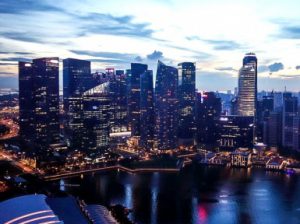
Столица Австралии
Многие почему-то считают столицей Австралии — Сидней, а кое-кто, называет даже Мельбурн. Это абсолютно не верно, хотя эти города претендовали на право быть столицей, но после провозглашения независимости Австралии в 1901 году австралийцы решили построить для своей столицы совершенно новый город…
Читать далее >
Здесь прекрасно уживаются христианские и католические соборы, кирхи и костелы, и прочие молельные дома. Даже принятая австралийцами конституция запрещает правительству устанавливать единую государственную религию, и как бы то ни было вмешиваться в свободу вероисповедания. Это создает особые благоприятные условия для отсутствия вражды различных конфессий.
Сегодня штат Западная Австралия — это более чем 2 миллиона человек 200 национальностей. Здесь население говорит на 170 языках и присутствует почти 100 религий. Но в свой национальный праздник — День основания Австралии, все австралийцы отмечают данью памяти тех, кто первыми пришел на эту землю и открыл её для потомства. В этот день принято отдавать почести тем кто обращает свой труд на благо народа. Чествуют тех, кто живет и работает в нынешнее время и строит еще более прекрасное будущее.
Самая почетная награда в Западной Австралии это звание «Житель штата года». Эту награду ежегодно вручают выдающимся современникам именно в этот день — День основания Австралии.
В этот день в доме правительства штата проводят большой бал Дня основания. Обычно этот бал организует губернатор штата.
Праздник в штате Западная Австралия
Многонациональная Австралия
День Австралии в Аделаиде
День Австралии в Сиднее
Этот день считают днем национальной гордости. Повсеместно организуются массовые гуляния, проходят праздничные концерты, устраивают встречи с ветеранами, проводят различные культурные и художественные выставки. В честь праздника дают в салют.
Золотой берег Австралии
Вдоль этого огромного пляжа, отгороженного от материка субтропическими лесами национальных парков, расположено большое количество отелей предназначенных для отдыха в любое время года. На курорт Gold Coast приезжают миллионы туристов со всех…
Интересные факты об Австралии
10-ть интересных фактов об Австралии Австралия — самый маленький континент в мире. Кенгуру и эму были выбраны в качестве символов австралийского герба, так как их, в отличие от других животных, они…
Канберра — фото и картинки
В галерее представленный фото Канберры — столицы Австралийского Союза, его основных районов и достопримечательностей. Ни для кого не секрет, что столица Австралии является крупнейшим городом Австралии. Это известно всем, а как…
Достопримечательности Канберры
Достопримечательности Канберры особая страница строительства и развития столицы Австралии. Канберра изначально строилась как столица Австралийского Союза. При создании Канберры, как новой столицы Австралии, для неё из штата Нового Южного Уэльса была…
День Австралии
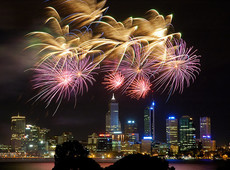
26 января 1788 года, спустя 18 лет после открытия континента Джеймсом Куком, в бухте Сиднея высадился и поднял британский флаг капитан Артур Филипп. Так была основана колония Нового Южного Уэльса, где первым губернатором стал тот же Артур Филипп. С этих пор началось плотное освоение австралийского континента европейцами. Через небольшой промежуток времени этот день стали праздновать в Новом Южном Уэльсе как Foundation Day, а лишь в 1946 году Австралийское правительство приняло решение отмечать 26 января во всех штатах как общенациональный праздник. Приказ отправить флот на покорение континента отдал секретарь Британской империи трудившегося с 1784 по 1789 годы Томас Тауншенд, в честь него и было названо первое европейское поселение «Сидней». Флот подошедший к берегам континента состоял из девяти товарных кораблей и двух военных — Сэпплая и Сириуса. В истории остались корабельные записи о то, что на прибывших судах находились 564 мужчины, 450 матросов, 192 заключенных женщин, военный и гражданский персонал, а так же 28 жен и 30 детей сопровождавших своих супругов и отцов. Вплоть до 1808 года этот день отмечался как День Основания или День первой высадки, но в 1818 году на 30 лет со дня образования колонии, губернатор Маккуаэри приказал палить из пушек и разрешил всем служащим не выходить на работу. В короткий промежуток времени эту традицию подхватили общественные организации и банки. В 1888 году все столицы колоний Австралии кроме Аделаиды празднично отметили столетие высадки европейцев на берега континента как День юбилея, а уже к 1935 году 26 января все штаты без исключения отмечали День Австралии. Продолжительное время законный выходной приходился на ближайший к 26 января понедельник, но начиная с 1994 года официальный выходной празднуется в стране четко 26 января. Австралийцы очень любят праздник День Австралии, как правило по всей стране проходят театрализованные шоу высадки первого флота, проводятся массовые парады и многочисленные регаты. Оканчивают празднование красочные фейерверки, а самые красивые световые шоу принято проводить в третьем по размеру городе Австралии — Перте. В Сиднее начинается в этот день музыкальный фестиваль, а в Аделаиде проводится соревнование по крикету. В городе Каберре традиционно проходит концерт живой музыки, а также там награждают самой почетной наградой этой страны, присуждая лучшим гражданам, статус Австралиец года. Так же в этот день обращается к нации с поздравлением премьер-министр страны. В этот день принято надевать патриотическую одежду с флагом Австралии и с нескрываемой радостью носить это на всех мероприятиях. Так же австралийцы любят украшать свои дома шарами и национальными флагами, чтобы праздничное настроение было везде. Очень интересна традиция в этот день коллегам австралийцев работающих за границей, дарить подарки. Так же поощряется долгий ленч и даже разрешено уходить с работы раньше положенного срока. Но всё таки большинство коренных австралийцев не британского происхождения воспринимают 26 января как День траура и лишения свобод коренных народов. Аборигены считая по праву себя хозяевами этих земель ратуют за восстановление своих прав жить так, как это было до высадки британцев, с уважением к своим традиция и культурному наследию. Для этого они прилагают все усилия, считая для себя позором радоваться этому историческому событию.
Праздники в других странах:
Календарь праздников
| Пн | Вт | Ср | Чт | Пт | Сб | Вс |
|---|---|---|---|---|---|---|
| 1 | 2 | 3 | 4 | |||
| 5 | 6 | 7 | 8 | 9 | 10 | 11 |
| 12 | 13 | 14 | 15 | 16 | 17 | 18 |
| 19 | 20 | 21 | 22 | 23 | 24 | 25 |
| 26 | 27 | 28 | 29 | |||
| Пн | Вт | Ср | Чт | Пт | Сб | Вс |
|---|---|---|---|---|---|---|
| 1 | 2 | 3 | 4 | 5 | ||
| 6 | 7 | 8 | 9 | 10 | 11 | 12 |
| 13 | 14 | 15 | 16 | 17 | 18 | 19 |
| 20 | 21 | 22 | 23 | 24 | 25 | 26 |
| 27 | 28 | 29 | 30 | 31 | ||
| Пн | Вт | Ср | Чт | Пт | Сб | Вс |
|---|---|---|---|---|---|---|
| 1 | 2 | |||||
| 3 | 4 | 5 | 6 | 7 | 8 | 9 |
| 10 | 11 | 12 | 13 | 14 | 15 | 16 |
| 17 | 18 | 19 | 20 | 21 | 22 | 23 |
| 24 | 25 | 26 | 27 | 28 | 29 | 30 |
Для улучшения работы сайта и его взаимодействия с пользователями мы используем файлы cookie. Продолжая работу с сайтом, Вы разрешаете использование cookie-файлов. Вы всегда можете отключить файлы cookie в настройках Вашего браузера.
Просматривая материалы сайта, Вы разрешаете использование cookie-файлов.



